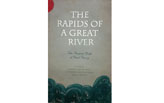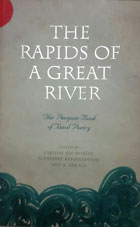BEYOND SANGAM, AKAM AND PURAM – PART II

 Auszug aus der Einführung zu Rapids of a Great River: The Penguin Book of Tamil Poetry.
Auszug aus der Einführung zu Rapids of a Great River: The Penguin Book of Tamil Poetry.
Edited by Lakshmi Holmström, Subashree Krishnaswamy and K. Srilata.
Pichamurti also brings a new tone of irony and colloquiality to his poetry; his choice of theme often reflects his engagement with the quotidian, as evidenced in his poem ‘Kurai’ (Grievance) where scavengers and ragpickers become the subject of enquiry.
If Pichamurti was among the first to break with the past, Gnanakoothan, following soon after the Ezhuttu poets, represents the maturing of modern poetry in Tamil. Open to experiment and completely unafraid in his choice of theme, Gnanakoothan (like his predecessor Pichamurti, but also like his contemporary, the writer of fiction, Ashokamitran) writes with great humour, wit and insight about the lives of humble, ordinary people. His cast of characters includes the inimitable ‘Cycle Kamalam’ and the energetic paper boy of ‘Paper paiyan’. In ‘Amma kundum idam’, the young boy from the village has a completely different experiential understanding of the train in contrast to the privileged city dweller. The speaker affirms, One train ran through his mind.
Another through mine.
On different tracks.
(Amma kundum idam, translated by Lakshmi Holmström, Subashree Krishnaswamy and K. Srilata) Gnanakoothan’s wry, ironic gaze is also evident in the poem ‘Ammavin poigal’ (Amma’s lies).
The Ezhuttu poets were not without their detractors. They were considered by critics such as Vanamamalai to be too self-reflective and introspective, their images too outlandish, their poetry—apart from that of Pichamurti—too esoteric and obscure at times. A new magazine, Vanambadi, came out in 1971, which claimed to be a corrective to the individualism of the earlier poets, and to speak instead for the socially oppressed. The left-wing progressive writers who became known as the Vanambadi group (Mu. Mehta, Meera, Puviarasu and Sirpi among others) popularised the new free-verse poetry, but used it largely as a means of promoting their political message. As we shall show in the next section, the Vanambadi group also greatly influenced the new writers from Sri Lanka.
In the late 1970s and 1980s, however, younger poets such as Kalapriya, Atmanam, Brahmmarajan, Kalyanji, Yuvan and Sukumaran were able to combine introspection and social awareness with reflective grace. Kalapriya borrowed heavily from the rural idiom and ambience with which he was most familiar. Atmanam, hard to pigeonhole, perfectly blended art and political consciousness to craft poems that work at many levels.
It is most strikingly apparent that in the late 1980s and1990s, Tamil poetry widened to include many voices from varied backgrounds, particularly those of women and Dalits. The marginal status of women in the Tamil literary canon and their relatively meagre output have been evident ever since classical times. Although thirty women poets are named in the Sangam period, only three important women poets appear to have made their mark on Tamil poetry as a whole: Avvai during the Sangam period, and the bhakti poets Karaikkal Ammai and Andal.
Tamil women have been writing and publishing in various literary genres for several decades now, but as far as poetry is concerned, it is only since the 1970s that we have seen a significant change. A few women poets, such as R. Meenakshi, were publishing throughout the 1970s and 1980s, yet it is only since the late 1980s that their poems appeared in significant numbers, both in anthologies and in single volumes. There could be a number of reasons for this: the presence of well-established women novelists and short story writers; the active support of women activists and critics; and the encouragement of literary magazines such as Kalachuvadu and Kanaiyazhi. At any rate, the boldness with which many Tamil women are writing about their inner lives today reflects the important change that has happened nationwide from the 1970s, as women have made their mark in many aspects of modern life.
In recent times, particularly since the 1990s, women poets’ contribution to Tamil poetry has been significant. In terms of themes, their work owes much to their engagement with the micro-politics of the quotidian. They also bring new perceptions to familial relationships; they have written with truth about the sudden end to childhood, about bleak marriages and the joys and sorrows of motherhood. Importantly, they have written explicitly about their awareness of their bodies and their sexuality.
These are completely new themes in Tamil poetry and go with a new aesthetic: unusual, closely observed images; and a new and direct language, the use of which some conservative readers have found shocking. The women poets, however, challenge what poetry is, and question the subject of poetry, and what being a poet means. For example, responding to the charge of being too overtly feminist and shrill, Vatsala writes in her poem: Forgive me . . .
My poems—
pieces of glass
drenched in blood—
pain you.
Tired from a day’s work,
reclining in an easy chair
what you need are lyrical poems
that caress your heart.
(Kannadi thundugallum malligai pookallum/ Glass pieces and jasmine flowers, translated by Lakshmi Holmström, Subashree Krishnaswamy and K. Srilata) She deliberately offers the ‘glass pieces’ in place of the expected and stereotypical. Similarly, in a moving poem about the material contexts that underpin women’s writing, Ilampirai outlines the reasons for not turning in a poem to an editor:
Sorry,
can’t send you the poem
you commissioned.
The mind is a void,
the body listless.
Left behind
in a relative’s house
is my little darling
tottering to take a step or two . . .
(Irupu nilai 2/Impasse 2, translated by Lakshmi Holmström, Subashree Krishnaswamy and K. Srilata). Like the women poets featured in this anthology, we find that Dalit poets too have opened up and extended the boundaries of modern Tamil poetry. The 1990s witnessed the flowering of Tamil Dalit literature, ushering in a whole new world inspired by Dalit cultural traditions, especially the performing arts. Dalit poets too, like Dalit writers of fiction, have set out to challenge received assumptions about literary canons, established aesthetics, and accepted proprieties of grammar and language use. Their bold use of dialect and raw images in these poems is meant to shock and disturb the reader. But more than that, we are invited to share the poets’ confrontation of their own felt experiences as Dalits. It is this that impels the reader to reconsider their definition of poetry, and to review their own world view.
In recent times, particularly since the 1990s, women poets’ contribution to Tamil poetry has been significant. In terms of themes, their work owes much to their engagement with the micro-politics of the quotidian. They also bring new perceptions to familial relationships; they have written with truth about the sudden end to childhood, about bleak marriages and the joys and sorrows of motherhood. Importantly, they have written explicitly about their awareness of their bodies and their sexuality.
These are completely new themes in Tamil poetry and go with a new aesthetic: unusual, closely observed images; and a new and direct language, the use of which some conservative readers have found shocking. The women poets, however, challenge what poetry is, and question the subject of poetry, and what being a poet means. For example, responding to the charge of being too overtly feminist and shrill, Vatsala writes in her poem: Forgive me . . .
My poems—
pieces of glass
drenched in blood—
pain you.
Tired from a day’s work,
reclining in an easy chair
what you need are lyrical poems
that caress your heart.
(Kannadi thundugallum malligai pookallum/ Glass pieces and jasmine flowers, translated by Lakshmi Holmström, Subashree Krishnaswamy and K. Srilata) She deliberately offers the ‘glass pieces’ in place of the expected and stereotypical. Similarly, in a moving poem about the material contexts that underpin women’s writing, Ilampirai outlines the reasons for not turning in a poem to an editor:
Sorry,
can’t send you the poem
you commissioned.
The mind is a void,
the body listless.
Left behind
in a relative’s house
is my little darling
tottering to take a step or two . . .
(Irupu nilai 2/Impasse 2, translated by Lakshmi Holmström, Subashree Krishnaswamy and K. Srilata). Like the women poets featured in this anthology, we find that Dalit poets too have opened up and extended the boundaries of modern Tamil poetry. The 1990s witnessed the flowering of Tamil Dalit literature, ushering in a whole new world inspired by Dalit cultural traditions, especially the performing arts. Dalit poets too, like Dalit writers of fiction, have set out to challenge received assumptions about literary canons, established aesthetics, and accepted proprieties of grammar and language use. Their bold use of dialect and raw images in these poems is meant to shock and disturb the reader. But more than that, we are invited to share the poets’ confrontation of their own felt experiences as Dalits. It is this that impels the reader to reconsider their definition of poetry, and to review their own world view.
Excerpted with permission from Penguin Random House India



